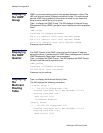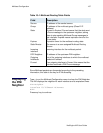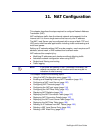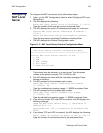
NetEngine IAD User Guide
NAT Configuration 194
Configuring
the NAT
Port Range
The size of the NAT port range defines the number of simultaneous
connections permitted. A small port range limits the number of
connections. Since the range that you assign must be outside the range of
assigned ports, do not set port ranges under 5,000.
Under normal circumstances, the port range default setting is adequate.
However, if you interact with products including multiple-player IP games
or video conferencing, you need to configure the port range setting.
To multiplex several connections to a single destination, the IAD assigns
all packets unique port numbers. Each IP packet starts with a header that
contain the source and destination addresses, as well as two port
numbers. The addresses specify the two routers at each end, while the
two port numbers ensure the unique identification of each router pair.
When the IAD sends TCP or UDP connection from a local port to an
Internet port, it changes the sent IP address to the address of the Internet
port. Similarly, it changes the TCP or UDP connection port number to a
unique value within the NAT port range.
You can display the NAT settings with the Display NAT Local Server Table
command.
To configure the NAT port range:
1. Type R on the NAT Configuration menu to select the Configure NAT
Port Range.
2. The IAD displays the low end port range prompt:
Enter Low End of NAT Port Range (5000..65534):
(50000)
Type the low end value and press Enter.
3. The IAD displays the high end port range prompt:
Enter High End of NAT Port Range (50000..65534):
(50000)
Type the high end value and press Enter.
4. The IAD saves the configuration and displays the NAT Configuration
menu.
5. Continue with other NAT configuration tasks, or press Escape to return
to the Main menu.
6. Reset the IAD (page 15) when you finish configuring NAT.
NOTE
Ensure that the NAT port range does not include any ports
that use applications such as HTTP, TFTP and so on.


















